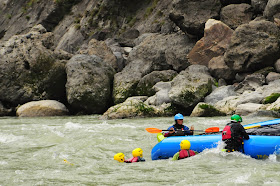 |
| Good days & Bad days in Iceland Lots of people make the common misconception that if you can kayak you are already a professional safety kayaker. This may not be the truth. |
Many potential rafting customers are now approaching rafting companies and asking if safety kayakers are present on their commercial trips. The need and demand to have professional safety kayakers is raising all of the time. But what makes a professional commercial safety kayaker ?.
 |
| Nanu Gurung of Paddle Nepal |
Training
A solid background of professional training is going to go a long way.
Solid training will give a safety kayaker the tools and skills to be able to deal with any arising situation in a professional cool, calm & collective manner. This in turn will also increase the safety kayakers confidence on the water.
The International rafting federation safety craft workshop is the perfect place to gain such training. The workshop consists of the following training and assessment elements.
- Personal kayak skills assessment on class 3 whitewater or class 4-5 whitewater
- Commercial trip management from a safety kayak perspective including river running signals, communication & positioning
- Throwbag skills test
- Ropework and mechanical advantage test
- Safety kayak specific customer safety brief
- Personal swim test
- Dealing with unconscious casualties from the kayak
- Exiting a Kayak in a rugged environment
- Taking command of a raft from your kayak including vocal commands and pushing /towing a raft
- Exiting your kayak entering a raft and taking command of the raft whilst in a rapid
- Dealing with multiple panicking swimmers Accessing an upturned raft from your kayak and re flipping the raft.
The rescue 3 & IRF systems are both globally recognized awards so each guide or safety kayaker holding these awards should have an identical skill set.
A wilderness or advanced first aid certificate is an absolute must for any guide working in the outdoors with commercial paying customers.
Experience
As with anything in life. A task carried out by somebody with experience of the given task is going to complete the task much more easier.Compared with someone who has never carried out the given task. So what experience does a safety kayker need in order to be a true professional?.
- Personal kayaking experience and the ability to control your kayak in a variety of conditions & situations is a must. A Proficient safety kayaker should be confident running rapids whilst having 1 or maybe 2 swimmers holding onto his or hers kayak.
- Operating river experience. A sound knowledge of the river in all water conditions is also a must. A key skill of a professional safety kayaker is to identify potential hazards and flipping spots for the rafts and to be able to communicate them to the rafts in a clear way . Knowing that on a certain level that feature x will be a nasty hole or a protruding rock with pin potential will allow the kayaker to pre position them self in a place where they can help the rafts in a quick manner should a problem occur. In my earlier days I was taught that a good safety kaykaer should know their river that well they should be able to run it backwards with their eyes closed alone . A bit far fetched but true in a way!
 |
| Binod Gurung of Wet n Wild explorations, lardo rapid Lower Indus India |
- Experience of working within a tight team of guides also plays a key part. Knowing the strengths and weaknesses of your fellow guides will make the life of a safety kayaker much more easy in the long run. Knowing that in high water guide x normally flips in a certain rapid will give you the time to be prepared for the possibility of a flip with swimmers as a result of this. knowing if a certain guide sometimes struggles to climb back onto an upturned raft after a flip will help you to offer them assistance if they need it. The same applies vice versa the raft guides need to be confident that the safety kayaker is going to be able back them up and deal with swimmers or a flip should they occur or that the correct signals are given when running a river in higher than normal conditions.
 |
| Notice the safety kayaker on hand to assist with any help if needed. Kali Gandakhi river Nepal. |
The age old saying "There is no substitute for experience" is age old for a reason !
Judgement
Finally without experience or the correct training your judgment will be impaired. The ability to make snap judgement decisions based on training & experience is one of the main skills of a good safety kayaker. The ability to decide which customer to help first in a scenario with multiple swimmers could potentially prevent somebody from a nasty injury. The decision to give a signal to a raft to avoid a large pour over that could flip the raft is a key judgement decision. The decision keep a little distance from a panicking swimmer until they calm down a little before you commit yourself to assisting them with a tow from your kayak is always a key judgement decision.
This Triangle brings together the big 3. Solid training & experience combined will allow you to make better judgement calls.
Hopefully this has given you more of an insight into safety kayaking. see you on the river
Mark.
Hopefully this has given you more of an insight into safety kayaking. see you on the river
Mark.

No comments:
Post a Comment